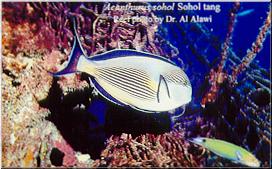MARINE AQUARIST™ Mid East correspondent Dr. Hameed Al Alawi, Ph.D. in Marine Biology and Advisor Committee member OFI. Dr. Al Alawi is the creator and director of Bahrain Waterlife Centre. Bahrain Waterlife Centre is considered to be the world’s foremost collector and supplier of marine fish and reef invertebrates from the Red Sea, Arab Sea and the Arabian Gulf areas. P.0. Box 2044, Manama, Bahrain. Fax +973-732770. E-mail: Waterlif@batelco.com.bh

Michael Del Prete and Dr. Al Alawi at Bahrain Waterlife Centr |
The holding facility at Bahrain Waterlife Centre is about 9000 US gallons. There are two separate systems with over 260 tanks. Each system utilizes bio-towers. With BI OX® media, air strippers, protein skimmers and bio-filters. Dissolved oxygen is kept at saturation. The pH is kept at 8.25-8.3. All marine life is acclimated to a specific gravity of 1.024.
Bahrain Waterlife Centre has its own collecting stations in different regions. Each collecting station is equipped with protein skimmers, UV, bio-filters, bio-towers with BI OX® media. Although each collecting site is located on the sea, each facility uses 100% Marine Environment® dual phase formula for holding, maintaining and shipping. Hydro-Safe™ is used in all shipping water.
RED SEA: A long narrow body of water with limited areas of continental shelf. The Red Sea extends in a general Northwest – Southeast direction for about 2000 Km (about 1250 miles) and has a maximum width of 352 Km (about 220 miles) in the vicinity of Gizan which is the border of Saudi Arabia and Yemen. The area of the Red Sea is about 438,000 Sq. Km (about 273,750 Sq. miles). the depth of the Red Sea averages 500 meters (about 1575 feet) though in certain places it may exceed 2500 meters (about 7850 feet).

Petrois radiata& Chaetodon Semilarvarius (Golden Butterfly) Aquarium photos by Dr. Al Alawi |
The Red Sea is one of the hottest and most saline seas on earth. It takes its name from the seasonal abundance of billions of minute algae. Trichodesium erythraceum. T. erythracheum live near the surface of the sea. They contain reddish or brown pigments which discolor at the surface of the water in some areas, at certain times. Hence the name Red Sea.
ARAB SEA: The Arab Sea is the rocky coast of Oman. Aden up to the Yemen border. It is part of the Indian Ocean and has a constant promise of discovering new places. The relative remoteness of the rocky coasts and islands has helped to preserve their natural beauty and wildlife. Consequently, these areas offer dramatic scenery and huge growths of corals and algae with plentiful marine fauna and flora
ARABIAN GULF: The Arabian Gulf forms a shallow arm of the Arabian Sea between Iran and Arabia. It is linked with the Arab Sea by the strait of Hormuz and the Gulf of Oman. It is a semi-enclosed sea with an axis length of some 10000 Km (about 625 miles). The Arabian Gulf varies in width from 200-300 Km (about 125-187 miles) and an area of about 226,000 Sq. Km (about 41,250 Sq. miles).
The greatest coral development is found around the low sandy islands which extent Northwards. In the deeper water, below 20 meters the bottom varies from coarse gravel and shell to extremely fine clay and mud. The later becoming dominant the further Eastward and therefore deeper one goes.

Acanthurus sohol Sohol tang
Reef photo by Dr. Al Alawi |
Some of the fish collected from these areas: Asfur, Imperator Koran and Maculosus angelfish, Purple, Sailfin and Sohal tangs, Clarki and Bicinctus clownfish, clownfish, Assasi triggerfish and Orange dotty back, Nigropuncatatus, Pheudochromis pericus, Semi larvartus, Larvartus, Mesoloucus and Melaterus butterfly fish, Radiata Lion and Volitan lion fish.
Fish are collected by means of scuba diving up to a depth of 20 meters (about 65 feet). All fish are hand caught by net, sometimes with two divers, without using any drugs. Large or breeder size fish are not taken unless requested by a public aquarium so they can procreate in the wild. Fish are gradually brought to the surface to avoid potential swim bladder damage. Each fish is carefully examined then bagged individually with 100% oxygen on the collecting boat.
All marine life collected in the Red Sea, Arabian Gulf and Arab Sea are acclimatized at the collecting sits, then shipped to Bahrain for further acclimatization and final shipment to foreign lands. All marine life is held for a minimum of 7 days in 100% Marine Environment® dual phase formula™ before being shipped internationally. Hydro-safe™, a stress and shock reducer is used in all shipping water.
 Marine Environment® dual phase formula™ & Hydro-Safe™ are the two items used to ship Red Sea fish around the world. Marine Environment® dual phase formula™ & Hydro-Safe™ are the two items used to ship Red Sea fish around the world. |